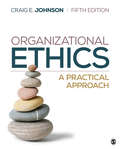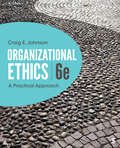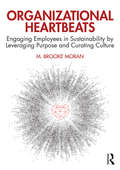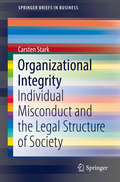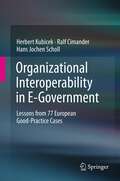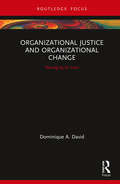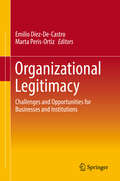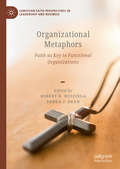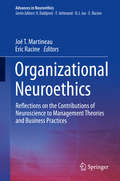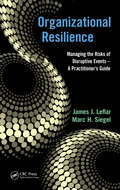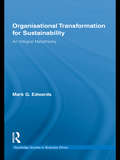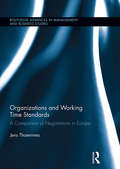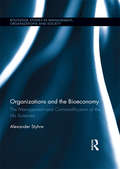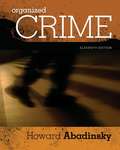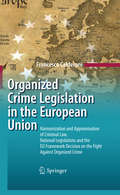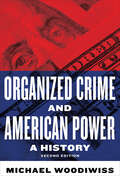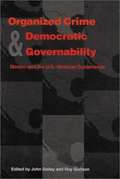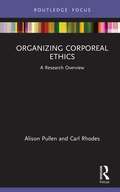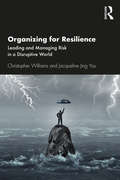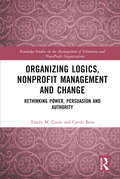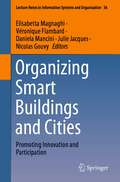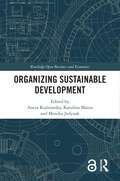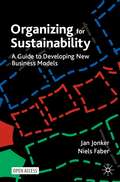- Table View
- List View
Organizational Ethics: A Practical Approach
by Craig E. JohnsonWith an interdisciplinary focus, Organizational Ethics equips students with the knowledge and skills they need to make a positive impact in a variety of workplaces. Author Craig E. Johnson builds the text around interdependent levels of organizational behavior, examining ethics at the individual, group, and organizational levels. Self-assessments, reflection features, and application projects give students ample opportunity to practice their ethical reasoning abilities. The Fifth Edition includes over 25 new case studies on current events and prominent figures, 24 new self-assessments, and new discussions on topics such as cross-cultural ethical conflict and organizational virtue.
Organizational Ethics: A Practical Approach
by Craig E. JohnsonOrganizational Ethics: A Practical Approach, Sixth Edition provides readers with opportunities to apply ethical principles and practices in a variety of settings through self-assessments, analyses, projects, and discussion. Bestselling author, Craig E. Johnson, shows how we can develop our ethical competence, just as we develop our abilities to manage or oversee operations.
Organizational Ethics: A Practical Approach
by Craig E. JohnsonOrganizational Ethics: A Practical Approach, Sixth Edition provides readers with opportunities to apply ethical principles and practices in a variety of settings through self-assessments, analyses, projects, and discussion. Bestselling author, Craig E. Johnson, shows how we can develop our ethical competence, just as we develop our abilities to manage or oversee operations.
Organizational Heartbeats: Engaging Employees in Sustainability by Leveraging Purpose and Curating Culture
by M. Brooke MoranThis employee engagement book focuses on the HOW of engaging employees in sustainability through four diverse case studies, thought-prompting questions and tips, as well as a unique model of employee engagement to guide strategy. The book includes both the mechanics of engagement and also the art of engagement through practices of authenticity, collective leadership, curating culture, and leveraging purpose. The power of purpose-driven employee engagement efforts featured in this book will inspire readers to help employees thrive, as a by-product of doing so is retaining employees, who effectively drive strategy, which lifts the organization and bolsters the economic bottom line. Numerous examples of successful engagement initiatives at Dubai Chamber of Commerce and Industry, Arizona State University, Seventh Generation, and Danone North America will catalyze readers’ imaginations regarding what is possible at their organizations. Moran’s purpose-driven employee engagement model will guide readers and their teams to hone initiatives into ones that will align with the heart and the systems of the organization. Prompting tips and questions throughout the text invite readers to engage with the material, so it is advised to have a notebook to record ideas while reading. Whether sustainability directors, human resource or talent management professionals seeking guidance on how to engage employees, middle managers striving to drive organizational change, or business school students wanting to learn about purpose-driven organizations, this book provides myriad tangible resources, as well as inspiring cases, to support the human capital that serves as the heart of organizations.
Organizational Integrity: Individual Misconduct And The Legal Structure Of Society (Springerbriefs In Business Ser.)
by Carsten StarkThis book describes the results of a research project on compliance and organizational integrity, financed by the German government and conducted over the last three years. The book offers a theoretical framework and valid instruments for measuring the outcome of compliance management: organizational integrity. To pinpoint the specifics of organizational integrity, and to create a framework for assessment, the book analyzes not only the cases of Siemens and Deutsche Bank but also a specific form of organization: governmental organizations. The book includes the results of a survey of employees in five German cities, in the course of which the author conducted interviews with the personnel responsible for compliance in different organizations. In addition, during their discussions he analyzed the administrative staff with regard to the decision-making processes they were involved in.
Organizational Interoperability in E-Government: Lessons from 77 European Good-Practice Cases
by Herbert Kubicek Hans Jochen Scholl Ralf CimanderIn the e-government research community as well as in many national e-government programs, interoperability is widely seen as a key factor in developing effective and attractive e-services. There is also agreement that interoperability encompasses not only mere technical standards and interfaces, but also includes organizational, legal, and cultural aspects. Several interoperability frameworks have been introduced on national and international levels, and recommendations have been made for the adaptation of enterprise architectures in the public sector. Common to all these approaches is their top-down deductive procedure, which does not connect very well to the real world of e-government projects. In contrast, in this volume, which is based on empirical research, the authors introduce a bottom-up inductive approach to deal with the challenges of interoperability-related governance. Based on so-called "good-practice" cases of interoperability in e-government, they derive concepts and classifications that help to uncover and assess similarities and differences between the cases. As a result, they present an empirically based conceptual framework that details the options for IT governance of interoperability in government. In addition, their findings also make it possible to critically assess and improve other existing frameworks. With this work, which combines different thematic foci as well as a European and a US background the authors situate empirical results in the broader context of theoretical and political reflection. Thus they provide insights into strategic choices for CIOs in e-government at a national or regional level, experiences and lessons learned for managers and developers in e-government projects, and a huge set of empirical data for administrative and political scientists.
Organizational Justice and Organizational Change: Managing by Love (Routledge Focus on Business and Management)
by Dominique A. DavidAlthough various factors contribute to failed change, one of the key reasons for change failure is the inability of leaders to gain the trust of employees, to understand the interaction between their subordinates, and to convince them to support change and to commit the energy and effort necessary to implement it. The aims of this book are to establish theories in order to describe and explain how human behaviors and contexts interact dynamically in these changes, and manage change and justice by reducing inequalities, giving emphasis to distributive justice. In addition, the aim of this book is also for readers to better understand employees' perceptions of organizational justice by senior management which is particularly important during the organizational change because change cannot succeed without the acceptance and support from employees. Organizational Justice and Organizational Change: Managing by Love provides readers a theoretical understanding and recommendations for acting properly in an organization, forming a comprehensive tool and better enable practitioners to achieve management of change and justice in organizations. It will be of interest to researchers, academics, practitioners, and students in the fields of change management, organizational studies, leadership, and strategic management.
Organizational Legitimacy: Challenges And Opportunities For Businesses And Institutions
by Marta Peris-Ortiz Emilio Díez-De-CastroThis volume explores organizational legitimacy in business, featuring examples from a variety of industries around the world. Synthesizing the most current theoretical insights and best practices, the contributing authors examine the ways in which organizational legitimacy can be understood, its perceived influence on the market, and the relationship between organizational legitimacy and overall organizational success. The authors draw from different methodological perspectives to develop a holistic approach to organizational legitimacy that transcends the traditional concepts of corporate reputation, business ethics or corporate social responsibility. Historically, efforts to understand how organizations acquire, manage and use legitimacy have applied insights from institutional theory, resource dependence theory, organizational ecology and stakeholder theory, but the field has remained fragmented, despite the profound implications of achieving legitimacy for ensuring organizational stability, survival and sustainability through access to capital, resources and business opportunities, as well as problem solving, performance measurement and stakeholder support. Presenting case studies of successful initiatives, the book addresses: · How organizational legitimacy is defined and measured · How organizations achieve legitimacy and how they acquire resources · How different stakeholders (e.g., consumers, investors, employees) make legitimacy judgments and resource allocation decisions · Whether audiences in the same socio-cultural context arrive at shared legitimacy judgments with regard to a focal organization
Organizational Metaphors: Faith as Key to Functional Organizations (Christian Faith Perspectives in Leadership and Business)
by Robert B. Huizinga Debra J. DeanThis edited volume expands on Morgan's organizational metaphors through the lens of faith to illuminate organizational function. Part I uses metaphor to illustrate dysfunctional organizations, including the impact of dysfunction upon organizational trust, performance, and longevity. Part II examines the progression from a dysfunctional organization to one that exhibits functionality. Finally, the last section discusses healthy organizations. Metaphors used in this book include Pygmalion organizations, organizational zombies, and organizations as vineyards. This book offers new metaphors that can be applied in organizational theory.
Organizational Neuroethics: Reflections on the Contributions of Neuroscience to Management Theories and Business Practices (Advances in Neuroethics)
by Eric Racine Joé T. MartineauUnderstanding and improving how organizations work and are managed is the object of management research and practice, and this topic is of longstanding interest in the academia and in society at large. More recently, the contribution that the study of the brain could make to, notably, our understanding of decisions, emotional reactions, and behaviors has led to the emergence of the field of “organizational neuroscience”. Within the field of management, organizational neuroscience seeks to explore linkages between neuroscience research, theories, and methods and management research. Its primary goal is to incorporate findings on the cognitive processes underlying the thoughts, behaviors and attitudes of organizational actors in order to better inform management theories, and to assist in understanding, predicting and improving these behaviors in the workplace. As a result, we have seen in the last decade a flurry of research projects and publications in organizational neuroscience, as well as novel or rejuvenated innovations around neuromarketing, neuroleadership, and cognitive enhancement in the work place, to name a few. However, research and practical applications in organizational neuroscience pose profound ethical challenges about, for example, organizational responsibility in the responsible use of scientific innovation. Drawing on recent debates in the field, and in response to upcoming ethical challenges of organization neuroscience, this book introduces “organizational neuroethics” as an emerging interdisciplinary field that addresses the ethics of organizational neuroscience research and applications, as well as the neuroscience of organizational ethics. The first part focuses on the ethics of organizational neuroscience and several chapters tackle the ethics of neuromarketing or neuroleadership and discuss the ethical issues associated with neuroenhancement practice in the workplace. The second part of the book addresses cutting-edge topics in the neuroscience of organizational ethics. Written by international experts in the fields of management, neuroscience, ethics, and social science, this book will be of prime interest to practitioners, researchers and students in the various fields concerned with improving management research and practices, as well as organizational ethics.
Organizational Resilience: Managing the Risks of Disruptive Events - A Practitioner's Guide
by Marc H. Siegel James J. LeflarMoving towards resiliency is more than just implanting policy and procedure; it is a process that takes organizations on a winding path requiring patience and tolerance. A good deal of learning will have to take place during the trip and that is why it is necessary to have patience and tolerate the learning process. Organizational Resilience: Manag
Organizational Transformation for Sustainability: An Integral Metatheory (Routledge Studies in Business Ethics)
by Mark EdwardsDuring the 21st century organizations will undergo a level of radical and global change that has rarely been seen before. This transformation will come as a result of the environmental, social and economic challenges that now confront organisations in all their activities. But are our understandings and theories of change up to the task of meeting these challenges? Will we be able to develop sustaining visions of how organizations might contribute to the long-term viability of our interdependent global communities? Organizational Transformation for Sustainability: An Integral Metatheory offers some innovative answers to the big questions involved in organizational sustainability and the radical changes that organizations will need to undergo as we move into the third millennium. This new approach comes from the emerging field of integral metatheory. Edwards shows how a "Big Picture" view of organisational transformation can contribute to our understanding of, and search for, organisational sustainability. There are four key themes to the book: i) the need for integrative metatheories for organisational change; ii) the development of a general research method for building metatheory; iii) the description of an integral metatheory for organisational sustainability; and iv) the discussion of the implications of this metatheory for organisational change and social policy regarding sustainability. This book brings a unique and important orienting perspective to these issues.
Organizations and Working Time Standards: A Comparison of Negotiations in Europe (Routledge Advances in Management and Business Studies #54)
by Jens ThoemmesCollective bargaining between employers and trade unions has profoundly changed working conditions in companies around the globe. But why do we start work at the age of 10, 16, 18 or 24? Why do we work 6, 8, 10 or more hours a day? These questions are becoming increasingly pertinent as working norms are fractured and fragmented by country. This book brings an entirely new perspective to our understanding of changes in working time. In both the UK and the US, effective legal or collectively-bargained regulation of working time has been limited over the last 20 years, to the extent that its disappearance is seen as almost unproblematic. Here author Jens Thoemmes sheds light on this transition and its economic implications with a fully evidenced sociological account, based particularly on original research into cases of working time standards in France and Germany. This book addresses the whole process of working time regulation over the last twenty years, evaluating the activities of trade unions, employers, and the State. While theories of industrial relations have already addressed the issue of markets in the context of collective bargaining, this book draws connections between time and markets, places these transitions in their historical contexts, and illustrates the importance of this movement crossing borders and cultures.
Organizations and the Bioeconomy: The Management and Commodification of the Life Sciences (Routledge Studies in Management, Organizations and Society)
by Alexander StyhreThe advancement of the life sciences and the technosciences has enhanced the longevity of citizens in the Western world, and half of the generation born in the first decade of the new millennium is now expected to live to the age of one hundred years. In a society with such longevity and affluence, consumption of health-related goods and services such as pharmaceuticals and scanning procedures may be seen as a sustainable source of income for the industries that promote it. Though the healthcare sector has traditionally been organized in the public sector in Europe and in the private sector in the US, the recent advancement of new therapies and direct-to-consumer marketing have opened up new streams of consumption and revenue for health care goods and services around the globe. This book examines the so-called ‘bioeconomy’ as a new economic and commercial field that emphasizes the management of individual life, including the regulation and control of weight and food consumption and other issues pertaining to individual well-being. In addition, the bioeconomy includes a variety of practices based on commercial interests such as organ donations, reproductive medicine and technologies, and what has been referred to as the tissue economy – the various forms of trade with human tissues. Author Alexander Styhre provides a thorough introduction to the bioeconomy, exploring this new and unique intersection of the life sciences and the technosciences with more traditional consumer markets.
Organized Crime
by Howard AbadinskyEver dynamic, organized crime continues to change. For example, efforts to combat one aspect of the phenomenon, the American Mafia, have reached high levels of prosecutorial success -- resulting in a decline in the organization's relative importance. Meanwhile, criminal organizations operating on a global scale have become more sophisticated and more threatening, and additional crime groups have been added to the pantheon we refer to as organized crime. Reflecting changes that have occurred in recent years, this eleventh edition updates information and analyses of organized crime, including how criminal groups around the world are organized; the widening of their business activities; and the statutes, agencies, and techniques used to combat them.
Organized Crime Legislation in the European Union
by Francesco CalderoniJust a few months after the entry into force of the EU Framework Decision on the fight against organized crime, this book provides an unprecedented analysis of the national and European legislation on organized crime. The book provides a critical examination of the European policies and legal instruments to promote the harmonization and approximation of criminal law in this field (including the United Nations Convention on Transnational Organized Crime). The current level of harmonization among EU Member States and the approximation to the standards of the new Framework Decision are discussed in detail, with the help of tables, graphs and maps. The results highlight the problems surrounding the international legal instruments and the inconsistencies of the national approaches to combating organized crime.
Organized Crime and American Power: A History, Second Edition
by Michael WoodiwissPopular histories of organized crime in the United States often look to the Mafia and the sons of early twentieth-century immigrants – such as Al Capone, Lucky Luciano, and Meyer Lansky – for their origins. In this second edition of Organized Crime and American Power, Michael Woodiwiss refocuses on US organized crime as an American problem. The book starts in 1789, with the birth of a new nation, intended to be run according to laws and conventions, with a written commitment to civil rights. Woodiwiss examines the organization of crime before the Civil War, which damaged or destroyed the lives of those excluded from constitutional protections: Indigenous peoples, Black people, and women. The book focuses on white supremacist crime and the pernicious influence of Southern leaders in alliance with opportunistic politicians. It examines the organized crimes of powerful business interests in alliance with politicians, as well as the corrupt consequences of the US moralistic campaigns against alcohol, gambling, drugs, and abortion. Organized Crime and American Power brings solid historical evidence and analysis to the task of refuting conventional wisdom that frames organized crime as something external to US political, economic, and social systems.
Organized Crime and Democratic Governability: Mexico and The U. S.-Mexican Borderlands (Pitt Latin American Series)
by John Bailey Roy GodsonOrganized Crime and Democratic Governability brings together scholars and specialists, including current and former government officials, from both sides of the border to trace the history and define the reality of this situation. Their diverse perspectives place the issue of organized crime in historical, political, economic, and cultural contexts unattainable by single-author studies. Contributors examine broad issues related to the political systems of both countries, as well as the specific actors—crime gangs, government officials, prosecutors, police, and the military—involved in the ongoing drama of the border. Editors Bailey and Godson provide an interpretive frame, a “continuum of governability,” that will guide researchers and policymakers toward defining goals and solutions to the complex problem that, along with a border, the United States and Mexico now share.
Organized Crime as Institutional Cluster: Transition from Traditional to Informational Model in Ukraine (SpringerBriefs in Law)
by Tetiana MelnychukFrom the perspective of institutionalism and theories of clusters, this book provides a concept of organized crime as an institutional cluster in contrast to the concept of multiple offences, associated with organized criminal groups or/and criminal organizations. The book offers shifts in the methodology of organized crime analysis and extrapolates the tools of cluster modelling – successfully approbated in the social and economic sciences as a method for the organization of spatially localized systems – to the criminological field. Such an approach gives a fresh view of organized crime essence and contributes to the deeper and more sophisticated understanding of organized crime modus operandi, as well as its influence on the social landscape.Organized crime in today’s world is increasingly moving from rigidly structured entities to decentralization with unclear, blurred edges and a hybrid structure, which is dictated by the rationality of adapting to social change, including the emergence of new widespread demands for illegal goods and services, new ways to evade social control, the prevalence of poly-criminal activities, the involvement in general digitalization, and so on. Specifically, the study is focused on the evolution of organized crime models in Ukraine considering the socioeconomic, political, and ideological background. Organized crime in Ukraine has gone through numerous transitions, encompassing professionally or traditionally organized criminal groups (the so-called community of ‘thieves in law’), functional racketeering groups, businessmen who accumulated their initial capital through the shadow economy, bureaucratically constructed groups from former official vertically powerful ruling circles, networks of personal or professional connections of the Soviet special services, oligarchic-clan pyramidal structures and amorphous delocalized cyber entities.This book also gives a broad picture of contemporary criminal clusters in Ukraine and an assessment of a full-scale war’s impact. Russia’s invasion on 24 February 2022 and massive hostilities provoked a turbulent situation for organized crime, resulting in the breaking of former criminal ties and the degradation of certain criminal and corrupt practices. At the same time, the war and the martial law regime created opportunities for organized crime in Ukraine to develop new illegal markets and relocate existing ones.
Organizing Corporeal Ethics: A Research Overview (State of the Art in Business Research)
by Alison Pullen Carl RhodesThis book explores the meaning and practice of corporeal ethics in organized life. Corporeal ethics originates from an emergent, embodied and affective experience with others that precedes and exceeds those rational schemes that seek to regulate it. Pullen and Rhodes show how corporeal ethics is fundamentally based in embodied affect, yet practically materialized in ethico-political acts of positive resistance and networked solidarity. Considering ethics in this way turns our attention to how people’s conduct and interactions might be ethically informed in the context of, and in resistance to, the masculine rationality of dominating organizational power relations in which they find themselves. Pullen and Rhodes outline the ways in which ethically grounded resistance and critique can and do challenge self-interested organizational power and privilege. They account for how corporeal ethics serves to destabilize the ways that organizations reproduce practices that negate difference and result in oppression, discrimination, and inequality. The book is suitable for students, scholars and citizens who want to learn more about the radical possibilities of how political actions arising from corporeal ethics can strive for equality and justice.
Organizing For Resilience: Leading and Managing Risk in a Disruptive World
by Christopher Williams Jacqueline Jing YouOrganizing for Resilience provides a fresh and novel insight into research on how leaders can prepare their organizations to face up to shocks and disruptions in a turbulent and unpredictable world. It provides an analysis of the topic of organizational resilience in a comprehensive and integrative way, with fresh theoretical and research implications as well as important implications for leaders.The first book to synthesize themes from across a spectrum of resilience using the metaphor of a ‘resilience landscape’, chapters in Part I are devoted to five analytical levels: individual level resilience; small firms in which major disruption can threaten survival; large firms with disruptions in one part of the organization; large firms facing enterprise-wide disruption; and disruption to a complete community or economic ecosystem of individuals and organizations. Cases and practice insights are presented to bring the topics to life, allowing reflection and debate at each level. In Part II, the construct of the ‘resilience landscape’ is developed, along with a discussion on leadership for resilience by instilling a resilience mind-set and developing capabilities in relational resilience.The book is ideally suited to bachelor’s and master’s degree courses on strategy, organizational behaviour and leadership. PhD and DBA researchers in the field of resilience and strategy will also find the book useful, as will practising consultants and business leaders.
Organizing Logics, Nonprofit Management and Change: Rethinking Power, Persuasion and Authority (Routledge Studies in the Management of Voluntary and Non-Profit Organizations)
by Tracey M. Coule Carole BainNonprofit organizations are conventionally positioned as generators of social and cultural forms of capital for the common good. As such they occupy a different space to other types of organizations such as corporate firms that exist primarily to generate economic capital for private owners/shareholders. Recent years, however, have seen professionalization promoted widely by funders, policy-makers and nonprofit practitioners across the globe. At the same time, there has been an increasing cross-over of employees from private and public bodies into nonprofits. But do such shifts open up space for the wholesale importation of managerialism into and commercialization of the nonprofit sphere? Are nonprofits at risk of being reconstituted as primarily economic entities, serving the interests of a leadership elite? How are such changes in an organization’s trajectory brought about? What are the consequences for trustees, staff, members and the nature of managerial work? The authors engage with critical questions such as these through a unique insider account of one professional institute experiencing unprecedented changes that challenge its very reason for being. Drawing on a three-year ethnography, they narrate organizational inhabitants’ struggles in their search for purpose and analyze the myriad of changes within different aspects of organizing including structure, strategizing, pay and reward, governance and leadership. The book will enable readers to reframe and rethink organizational change as a process involving power, persuasion and authority, and will be of value to researchers, students, academics and practitioners interested in managerial work and organizational change in non-profit organizations.
Organizing Smart Buildings and Cities: Promoting Innovation and Participation (Lecture Notes in Information Systems and Organisation #36)
by Daniela Mancini Elisabetta Magnaghi Véronique Flambard Julie Jacques Nicolas GouvyThe United Nations included sustainable cities and communities in its 2030 SDGs. Cities and, on a smaller scale, neighborhoods, building managers and firms are now adopting technologies and information systems to help achieve the energy, economic, social and environmental transition. This volume gathers contributions on the key organizational success factors for this transition.To do so, it analyzes the role of information systems, use of data, and technological assistance solutions from multiple perspectives. The goal is to develop a framework that can successfully apply information systems to organizational and environmental issues for smart cities and smart buildings. Accordingly, the book addresses living-lab experiment evaluation techniques, and provides critical analyses of the role of the environment, context and users’ behavioral responses. In addition, it discusses key questions on the efficient management of resources, need for appropriate IT solutions, and employing co-creation with users to improve planning and organization.
Organizing Sustainable Development (Routledge Open Business and Economics)
by Aneta Kuźniarska Karolina Mania Monika JedynakThe role and meaning of sustainable development have been recognized in the scientific literature for decades. However, there has recently been a dynamic increase in interest in the subject, which results in numerous, in-depth scientific research and publications with an interdisciplinary dimension. This edited volume is a compendium of theoretical knowledge on sustainable development. The context analysed in the publication includes a multi-level and multi-aspect analysis starting from the historical and legal conditions, through elements of the macro level and the micro level, inside the organization. Organizing Sustainable Development offers a systematic and comprehensive theoretical analysis of sustainable development supplemented with practical examples, which will allow obtaining comprehensive knowledge about the meaning and its multi-context application in practice. It shows the latest state of knowledge on the topic and will be of interest to students at an advanced level, academics and reflective practitioners in the fields of sustainable development, management studies, organizational studies and corporate social responsibility.
Organizing for Sustainability: A Guide to Developing New Business Models
by Jan Jonker Niels FaberThis upper-level Open Access textbook aims to educate students and professionals on how to develop business models that have a positive impact on people, society, and the social and ecological environment. It explores a different view of how to organize value creation, from a focus on an almost exclusively monetary value creation to one that creates positive impact through multiple values. The book offers students and entrepreneurs a structured approach based through the Business Model Template (BMT). It consists of three stages and ten building blocks to facilitate the development of a business model. Users, be they students or practitioners, need to choose from one of the three offered business model archetypes, namely the platform, community, or circular business models. Each archetype offers a dedicated logic for vale creation. The book can be used to develop a business model from scratch (turning an idea into a working prototype) or to transform an existing business model into one of the three archetypes. Throughout the book extra sources, links to relevant online video clips, assignments and literature are offered to facilitate the development process. This book will be of interest to students studying the development of business models, sustainable management, innovation, and value creation. It will also be of interest executives, and professionals such as consultants or social entrepreneurs seeking further education.
